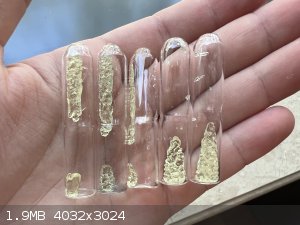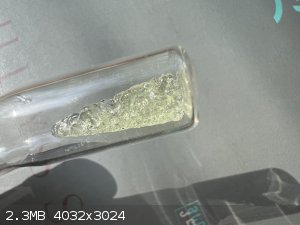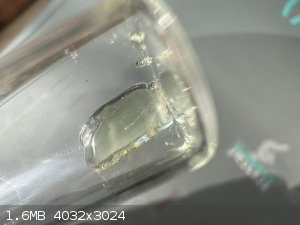vano
National Hazard
   
Posts: 661
Registered: 22-3-2019
Location: Georgia
Member Is Offline
|
|
Osmium chemistry
Hello! now I have a few ampoules of OsO4. I searched here but osmium chemistry is rare. I think what can I do with the oxide? I want something
interesting and I will take any advice.
 

|
|
|
DraconicAcid
International Hazard
    
Posts: 4278
Registered: 1-2-2013
Location: The tiniest college campus ever....
Member Is Offline
Mood: Semi-victorious.
|
|
Leave it ampuled. It's named after the way it stinks for a reason.
Please remember: "Filtrate" is not a verb.
Write up your lab reports the way your instructor wants them, not the way your ex-instructor wants them.
|
|
|
vano
National Hazard
   
Posts: 661
Registered: 22-3-2019
Location: Georgia
Member Is Offline
|
|
Sorry, I don't understand, not very good at English. but maybe you meant its toxicity.
|
|
|
Texium
Administrator
       
Posts: 4508
Registered: 11-1-2014
Location: Salt Lake City
Member Is Offline
Mood: PhD candidate!
|
|
If you do open it, be very careful. It’s surprisingly volatile and extremely toxic. It really should only be handled in a fume hood. You can inhale
a deadly dose at concentrations lower than you can smell.
Not sure about inorganic osmium chemistry, but the oxide itself is used extensively in organic chemistry as a catalytic oxidant. It’s usually used
with a stoichiometric amount of a re-oxidant like NMO, hydrogen peroxide, or ferricyanide, due to its high cost and toxicity. Most commonly this is
used to convert alkenes into cis-diols, and it can be extended to convert alkenes to two aldehydes, similar to ozonolysis, by addition of periodate.
See here: https://en.m.wikipedia.org/wiki/Lemieux–Johnson_oxidation
|
|
|
Texium
Administrator
       
Posts: 4508
Registered: 11-1-2014
Location: Salt Lake City
Member Is Offline
Mood: PhD candidate!
|
|
The word “osmium” is derived from the Greek word for “smell” because
of the tetroxide’s strong, unpleasant odor.
|
|
|
vano
National Hazard
   
Posts: 661
Registered: 22-3-2019
Location: Georgia
Member Is Offline
|
|
thank you! I will not work with it at home, of course in the laboratory. the best way is to crack it, put the broken ampoule in a solvent , and close
the bottle.
|
|
|
DraconicAcid
International Hazard
    
Posts: 4278
Registered: 1-2-2013
Location: The tiniest college campus ever....
Member Is Offline
Mood: Semi-victorious.
|
|
I did my thesis with compounds of rhodium and iridium, and some of my colleagues worked with osmium. One particular colleague would make large
batches of [PPN][HOs(CO)4] every few months- the entire lab would reek. Any piece of equipment (clamps, clips, etc) that he used would reek. I'd be
washing my hands an extra twelve times a day just because I'd accidentally pick up something that he had used.
Even years after he left, my supervisor would suggest that I try something with osmium, and I'd tell him to fuck off.
Please remember: "Filtrate" is not a verb.
Write up your lab reports the way your instructor wants them, not the way your ex-instructor wants them.
|
|
|
vano
National Hazard
   
Posts: 661
Registered: 22-3-2019
Location: Georgia
Member Is Offline
|
|
haha, that's bad. Now it's clear why you think about osmium like that.
|
|
|
BromicAcid
International Hazard
    
Posts: 3227
Registered: 13-7-2003
Location: Wisconsin
Member Is Offline
Mood: Rock n' Roll
|
|
From my recollection the big issue is damage to the eye tissues due to exposure to the tetroxide. Just be aware, as others have mentioned it's
surprisingly volatile.
|
|
|
vano
National Hazard
   
Posts: 661
Registered: 22-3-2019
Location: Georgia
Member Is Offline
|
|
Oh, i understand. Thanks for your advice!
|
|
|
teodor
National Hazard
   
Posts: 872
Registered: 28-6-2019
Location: Heerenveen
Member Is Offline
|
|
If I had that I would try those sequences of preparations ("->" means that the left is the starting material for the right):
- OsO4 -> KOsO3N -> K2OsCl5N
- OsO4 -> (NH4)2[OsCl6] (or (NH4)2[OsBr6]) -> [Os(NH3)5(N2)]I2 -> [Os(NH3)5I]I2
- (NH4)2[OsCl6] (or (NH4)2[OsBr6]) -> [Os(NH3)6]I3 -> [Os(NH3)5(NO)]I3 -> [Os(OH)(NH3)4(NO)]I2 -> [OsI(NH3)4(NO)]I2 ("I" could be
substituted with Cl or Br)
All those preparations were published in "Inorganic syntheses" (vol. 5, 6, 16). Except for the issues with the toxicity (of the starting compound) all
those syntheses are relatively easy and they don't require any exotic equipment/techniques/chemicals.
The interesting part is that to get any compound from the right you must perform all intermediate syntheses which can be a long-term project.
[Edited on 5-9-2022 by teodor]
|
|
|
Bedlasky
International Hazard
    
Posts: 1219
Registered: 15-4-2019
Location: Period 5, group 6
Member Is Offline
Mood: Volatile
|
|
Look at this book:
https://1lib.cz/book/2276103/0e932b
There is really detailed description of osmium chemistry.
|
|
|
vano
National Hazard
   
Posts: 661
Registered: 22-3-2019
Location: Georgia
Member Is Offline
|
|
thank you everyone!
|
|
|
teodor
National Hazard
   
Posts: 872
Registered: 28-6-2019
Location: Heerenveen
Member Is Offline
|
|
My favorite source of the information for Os chemistry is the 160+ pages article "RECENT ADVANCES IN OSMIUM CHEMISTRY" by PETER A. LAY and W. DEAN
HARMAN published in "Advances in inorganic chemistry vol. 37" @ 1991.
It is more comprehensive compared to Pergamon Press book, also it contains references to all previous publications.
You can find the book at the same (pirate) library.
|
|
|
Yamato71
Hazard to Self
 
Posts: 68
Registered: 8-2-2012
Member Is Offline
Mood: Resigned
|
|
OsO4 can instantly blind you if it or it's vapor contacts your eyes. Your corneas will turn irreversibly black due to reduction to metallic osmium
within the tissues. Osmium chemistry is one of my huge nopes.
|
|
|
vano
National Hazard
   
Posts: 661
Registered: 22-3-2019
Location: Georgia
Member Is Offline
|
|
yes of course. but I want to work with tetravalent osmium. I will reduce it with thionyl chloride and then remove all air with a vacuum. I will make
this reaction in the lab and it will be safe.
|
|
|
Keras
National Hazard
   
Posts: 769
Registered: 20-8-2018
Location: (48, 2)
Member Is Offline
|
|
Osmium tetroxide sole usage (in organic chemistry) is to transform a double bond into a gem-diol.
But this can be done also with potassium permanganate, which is orders of magnitude less toxic and dangerous for your eyes than OsO₄.
|
|
|
Bedlasky
International Hazard
    
Posts: 1219
Registered: 15-4-2019
Location: Period 5, group 6
Member Is Offline
Mood: Volatile
|
|
Why with thionyl chloride? If you plan to do aqueous chemistry, you can use some common reducing agent (for example sulfite).
|
|
|
njl
National Hazard
   
Posts: 609
Registered: 26-11-2019
Location: under the sycamore tree
Member Is Offline
Mood: ambivalent
|
|
Because he's badass
Reflux condenser?? I barely know her!
|
|
|
vano
National Hazard
   
Posts: 661
Registered: 22-3-2019
Location: Georgia
Member Is Offline
|
|
I don't want to work with aqueous solutions, I want anhydrous tetrachloride to make organometallics in an organic solvent. also thyonyl chloride
reaction is something new and funny for me, i want to try it.
|
|
|
woelen
Super Administrator
        
Posts: 7977
Registered: 20-8-2005
Location: Netherlands
Member Is Offline
Mood: interested
|
|
Then I suggest
that you first try experimenting with thionyl chloride and other chemicals than OsO4. Reactions with thionyl chloride can be quite violent and can
produce lots of fumes/gases. The produced fumes/gases usually are of the SO2/HCl kind and can be dealt with by the more experienced home chemist, but
if there are osmium-containing vapors in it as well, then that could lead to very nasty surprises.
|
|
|
vano
National Hazard
   
Posts: 661
Registered: 22-3-2019
Location: Georgia
Member Is Offline
|
|
tetrachloride doesn't sublime. so when the reaction is finish, ill remove all gases with a vacuum.
|
|
|
woelen
Super Administrator
        
Posts: 7977
Registered: 20-8-2005
Location: Netherlands
Member Is Offline
Mood: interested
|
|
Maybe you don't get OsCl4 vapors, but what if some unreacted OsO4-vapors escape? Can you be sure that this does not happen, or that you can contain
the Os completely. I know from experience that with experiments with SOCl2 it is almost impossible to contain all of the huge amounts of HCl-fumes and
SO2-gas, which can be produced. Breathing a whiff of SO2 or HCl, or getting stinging eyes of SO2 or HCl is unpleasant, but not fatal. But getting
fumes of OsO4 in your eyes may be very serious for the rest of your life.
I once did an experiment with RuO2, and took a little pinch of that (maybe a few mg) and left this in an erlenmeyer with bleach in it. This gave a
nice deep red solution. I put this away, without a cap. Several days later, I came back and saw that the liquid had become colorless, and there was a
big stain on the workbench around the erlenmeyer. When I removed the erlenmeyer, the surface under it was still clean, the rest is considerably
darker. This happened a year ago or so. The stain still is there, I cannot remove it from the workbench. I tell this as a demonstration of how
extremely easily stains are obtained from minute quantities. And this was with RuO4. OsO4 is worse!
|
|
|
vano
National Hazard
   
Posts: 661
Registered: 22-3-2019
Location: Georgia
Member Is Offline
|
|
it is necessary to use exec thionyl chloride I think, it is an osmium oxide hydrate, so ill remove water also. I think the reaction will go at room
temperature, then I use a vacuum. I know that the water-thionyl chloride reaction produces HCl, which can form chloroosmic acid, but it must be small
contamination, but I can remove it with heating and a vacuum. It's good also that tetrachloride has 323C as the decomposition temperature.
there are some issues also, mostly theoretical for example SO2 as a bridging ligand, but I'm not thinking of such theoretical things, just low
possibility. the final step of synthesis must leave only tetrachloride.
also as I said I won't do the reaction in my homelab.
[Edited on 2-11-2022 by vano]
|
|
|
Fleaker
International Hazard
    
Posts: 1252
Registered: 19-6-2005
Member Is Offline
Mood: nucleophilic
|
|
OsO4 is actually rather nasty, much worse in comparison to even RuO4.
The first thing one notices is a halo around the lights when working with it and the vapors are escaping.
Neither flask nor beaker.
"Kid, you don't even know just what you don't know. "
--The Dark Lord Sauron
|
|
|